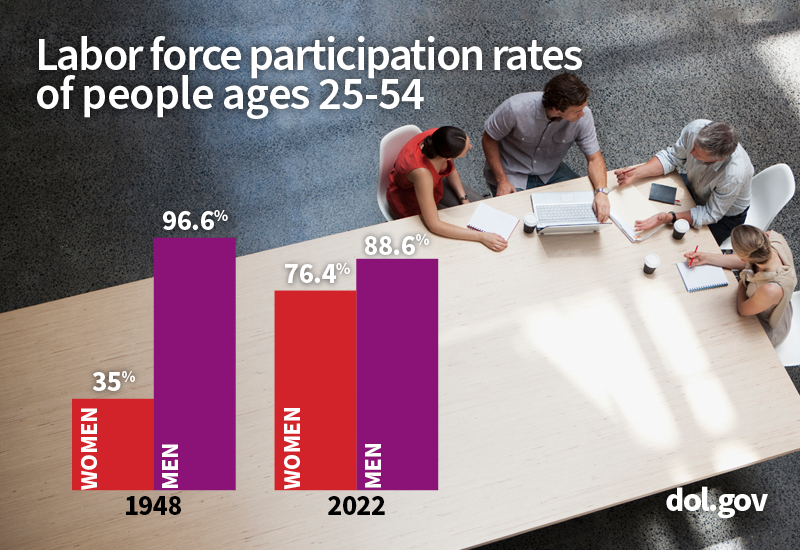Every year, Women’s Equality Day marks the anniversary of the ratification of the 19th Amendment. At the Women’s Bureau, we’re prompted to take stock of how women in the labor force are doing. So, we took a look at the data collected over the last year.
This June, the labor force participation of “prime-age women” women, ages 25-54, hit an all-time high. This marks a striking rebound from the early days of the COVID-19 pandemic, when women bore the brunt of job losses and many exited the workforce because of caregiving demands.
Recovery from the pandemic-related recession was the fastest on record and the economy is doing well overall. At the same time, there is still more work to be done. Adjusting for population growth, more than 700,000 adult women are still “missing” from the labor force. And too many people, especially women and people of color, are stuck in low-paid jobs with few benefits. So, we must think bigger than recovering lost jobs. Women need greater access to jobs that pay well, allow them to care for their health and their families, and come with union representation.

Enter Investing in America, the Biden-Harris administration’s signature economic plan to use federal infrastructure and clean energy funding to create good-quality jobs, and to promote equity in those jobs. The administration understands that when we talk about investments in infrastructure, we’re talking not just about roads and bridges, but about our workforce – our people. And in order for Investing in America to succeed, we must leverage the many sources of untapped talent who have historically lacked access to good jobs in construction and advanced manufacturing, and who have historically been left out of infrastructure booms. That of course includes women, who make up half the population and nearly half of workers, but only 4% of the skilled construction trades workforce and 29% of manufacturing workers.
So, how do we do that?
Help women access well-paying jobs in male-dominated sectors.
Construction and manufacturing are two fields poised to hire additional workers to fill jobs fueled by federal investments from the Bipartisan Infrastructure Law, the CHIPS and Science Act, and the Inflation Reduction Act. These industries are seeking to recruit more workers in a tight labor market, but a variety of factors keep women from accessing these jobs. That's why the Women’s Bureau, alongside the rest of the Biden-Harris administration, is working to ensure that recruitment, training and hiring for jobs on federally funded infrastructure projects is as equitable as possible.
At the Women’s Bureau, we have decades of experience providing technical assistance to scale strategies that ensure women have access to good jobs, including through our Women in Apprenticeship and Nontraditional Occupations and Tradeswomen Building Infrastructure grants. These strategies include encouraging pre-apprenticeships; collaborating with workforce intermediaries like tradeswomen organizations; supporting safe and healthy workplaces, free of gender-based violence and harassment; and focusing on supportive services like child care that we know help workers (and especially women) stay in the labor force.
Promote policies that allow everyone, including women, to thrive at work and at home.
For too long, care work, both in our homes and in the labor force, has been marginalized as “women’s work” and subsequently undervalued and underpaid. But care is the infrastructure upon which the economy, and society as a whole, relies, and we must invest in this infrastructure, too. The Women’s Bureau, the Department of Labor and agencies across the administration are focused on raising wages, improving benefits and encouraging unionization in care occupations – occupations disproportionately held by women and disproportionally low-paid. While the need for care – for children, older adults, people with disabilities and others – is on the rise, care jobs have not fully recovered from the pandemic. As these jobs come back, we will continue to work to ensure that they represent a pathway to the middle class.
Successful cities and states are taking steps to make care more affordable while lowering the barriers for workers to take unpaid care of themselves and family members. For example, 13 states and the District of Columbia have passed paid family and medical leave laws, with the governors of Minnesota and Maine signing bills into law just this summer. We welcome this progress and continue to work with state and local partners to encourage more positive policy changes.
Investing in America.
The Biden-Harris administration’s Investing in America plan has given us the tools we need to super-charge our economic recovery. But it would be a shame to let this opportunity to advance gender equity go to waste. As we continue to invest in America’s economic health – and as we mark the 103rd anniversary of the 19th Amendment – let's make sure that everyone, including women, is able to benefit.
Learn about Women’s Bureau grants that support nontraditional training opportunities for women.
Wendy Chun-Hoon is the director of the Women’s Bureau. Follow the Women’s Bureau on Twitter at @WB_DOL.

 U.S. Department of Labor Blog
U.S. Department of Labor Blog